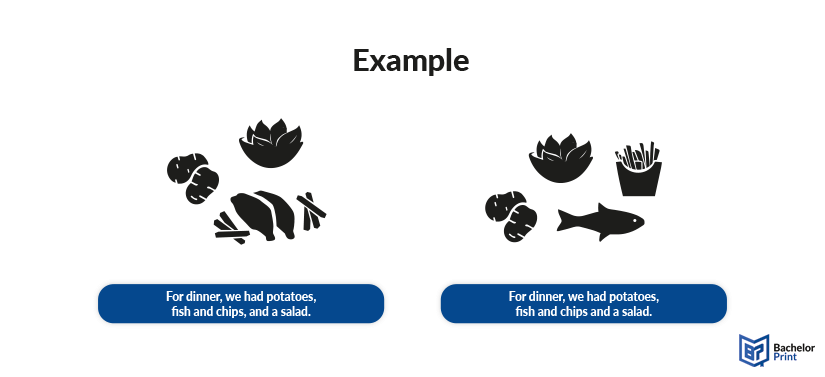
The Oxford (serial) comma, a tiny yet mighty punctuation mark, plays a significant role in written English, especially in academic writing. Among various commas, this bit of punctuation piece sparks lively debates among writers, editors, and grammar enthusiasts. While its use can influence the clarity of a sentence, opinions on its necessity vary. Should this pique your interest, continue onwards to learn more about its use.
Definition: Oxford (serial) comma
The Oxford comma, also known as the “Serial comma” or “Harvard comma,” is a punctuation mark used before the final conjunction in a list of three or more items. Its primary function is to clarify the separation between list items, ensuring that the reader understands each element as distinct. Its use varies among English style guides, with some advocating for its use for clarity, while others deem it optional. The term originates from its traditional use by the Oxford University Press.
History
The history of the Oxford comma dates back to the early 20th century, where its usage became associated with the Oxford University Press. While its precise origins are unclear, it gained prominence as a distinguishing feature of Oxford University’s style guide. The comma’s purpose was to bring clarity to lists, particularly in academic and publishing contexts. Over time, its usage spread beyond Oxford and became a subject of debate among grammarians and writers. Despite differing opinions on its necessity, the Oxford comma remains a recognizable punctuation mark in English writing, with its usage varying across different styles guides and regions. The word “comma” comes from the Greek root word “komma,” which means “a piece cut off” or “a short clause.” In ancient Greek grammar, it referred to a short clause or phrase within a sentence, often separated by commas for clarity or emphasis.
Example of using Oxford commas
In this example, the comma (or its lack) changes the grouping of the items listed for dinner:
The sentence with the Oxford comma implies, that there were three separate meals served: potatoes, fish and chips (as a single dish), and a salad. The latter sentence, however, could be interpreted as describing either the same three items as the first sentence or a different grouping, where “fish and chips and a salad” might be considered as one combined dish. However, it’s more likely to be understood as having the same meaning as the first one, with slight potential for ambiguity. The first one delineates the items more clearly while making it explicitly clear that “fish and chips” is a single item separate from the others.

Avoiding ambiguities with the Oxford comma
The Oxford comma is one of the most common punctuations in English grammar. Even though this comma may not change the grammatical correctness of a sentence, the lack of it may lead to ambiguity in your writing. Thus, incorporating the Oxford comma may help you avoid wrong expressions and improve your writing style.
Example of clarifying lists
Example of distinguishing between list of items & appositives
Example of enhancing readability
Use in British English vs. American English
The use of the Oxford comma is a matter of style and can vary between British English vs. American English, but it’s not exclusively tied to these varieties; rather, it often comes down to style guides and personal preference. In the following, you will find different style guide recommendations.
British English
In British English, the use of the Oxford comma is less standardized and more subject to personal or institutional preference compared to American English. Both, its use and omission are considered correct according to different style guides. Its application tends to be more discretionary, with recommendations for its use often linked to specific contexts where clarity is essential. The primary guide that explicitly endorses the Oxford comma is associated with the Oxford University Press (OUP). OUP, being a significant academic publisher, advocates for the use of the Oxford comma to prevent ambiguity in lists, particularly in formal, academic, and scholarly texts.
American English
In American English, the Oxford comma is widely used, especially in more formal writing, and is even deemed necessary by numerous American style guides. These include the APA style, The Chicago Manual of Style, Garner’s Modern American Usage, and the Strunk and White’s The Element of Style, all of which either recommend or mandate its use. On the other hand, the Associated Press Stylebook and the New York Times Style Book recommend not using it.
Note: However, when it is necessary to involve a comma to avoid ambiguity, both, American and British style guides, recommend using it.
Arguments for & against
The heated debate over the usage of the Oxford comma reflects differing perspectives on punctuation’s role in written communication. Advocates argue for its inclusion, citing benefits such as clarity and precision in lists.
For
- Clarity: Enhancing clarity, especially in complex lists.
- Consistency: Ensures uniformity and reduces ambiguity in writing.
- Precision: Adds precision by clearly delineating each list item.
Against
- Redundancy: Can be redundant, especially because of conjunctions.
- Aesthetics: May disrupt the flow of writing and clutter sentences.
- Space: Removing them can save space and create a more concise text.
- ✓ 3D live preview of your individual configuration
- ✓ Free express delivery for every single purchase
- ✓ Top-notch bindings with customised embossing

FAQs
The Oxford (serial) comma is a tiny bit of punctuation placed before the “and” that introduces the last subject in a list of at least three. In the US, it is also known as the serial comma and is much more used than in British English.
If you’re unsure whether to use this type of comma, try writing out your sample sentences with and without it. This will give you a better overview of whether the sentences are ambiguous or not. If a sentence has two different meanings, it may be relevant to add an Oxford (serial) comma to clarify its intended meaning.
To avoid ambiguity, you may use the serial comma to clarify the intended meanings of lists.
Example
Without an Oxford comma:
- He wants to visit his parents, Brady and Simone.
Here, it may be depicted that his parents are called Brady and Simone.
With an Oxford comma:
- He wants to visit his parents, Brady, and Simone.
Here, it may be depicted that he wants to visit his parents and two other people called Brady and Simone.
In American English, the serial comma is widely used and recommended by many style guides for clarity. British writers use it less common and often omit it in journalistic writing but included where its absence could lead to ambiguity. However, it is a matter of preference if the extra comma is applied or omitted.
No, not all style guides recommend it. For example, The Chicago Manual of Style and the APA Manual advocate for its use, while the Associated Press (AP Style) Stylebook generally advises against it, except where omitting it would lead to confusion. Regardless of the miscellaneous recommendations by style guides, the choice ultimately reflects your personal style.
